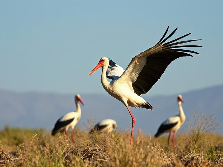
Rebel Storks: The Iberian Birds That Ditched Migration and Changed Everything
Picture this: It’s a crisp February morning in central Spain. Frost glistens on the fields, but instead of empty skies, giant black-and-white wings effortlessly ride the thermals above a sprawling landfill. Below, dozens of White Storks poke through the mountain of human detritus. This isn’t a scene from a dystopian novel. This is the everyday reality for thousands of Iberian White Storks – the original “Rebel Storks” – who made an audacious choice decades ago: they quit migrating. They looked at the exhausting, perilous journey to sub-Saharan Africa and said, “Nah, we’re good here.” And their story is one of the most compelling, and complex, wildlife adaptations happening right under our noses. Forget the textbook image of storks delivering babies; these birds are delivering a masterclass in behavioral plasticity and ecological consequence.
The term “Rebel Stork” isn’t just catchy; it perfectly encapsulates this dramatic behavioral shift. Traditionally, European White Storks (Ciconia ciconia) were the ultimate long-haul migrants. Every autumn, they’d gather in massive flocks, navigating thousands of kilometers over deserts, seas, and political borders to reach wintering grounds in the Sahel and savannas of Africa. Come spring, they’d make the arduous return to breed in Europe. It was a rhythm etched into their DNA over millennia. But starting noticeably in the 1980s, and accelerating rapidly, a significant chunk of the Iberian population just… stopped going. They became residents. Sedentary. Rebels against the ancient migratory imperative. Why? The answer lies in a potent cocktail of human-induced change: abundant food from landfills and intensive agriculture, coupled with increasingly milder winters due to climate change. Suddenly, the energy-sapping, predator-dodging, drought-risking journey south seemed less necessary. The payoff for staying put outweighed the peril of the trip.
This isn’t just a quirky anecdote; it’s a full-blown ecological phenomenon with profound implications. Understanding the Rebel Stork is understanding how human activities ripple through ecosystems in unexpected ways. We’re witnessing rapid evolution in action, a behavioral adaptation reshaping population dynamics, predator-prey relationships, and even conservation strategies. It challenges our assumptions about species’ needs and vulnerabilities. By delving into their story, we gain crucial insights into resilience, adaptation, and the unintended consequences of our modern world. So, let’s unpack the fascinating saga of these avian revolutionaries.
The Great Iberian Staycation: Unpacking the Rebel Stork Phenomenon
So, how did this rebellion actually take root? It wasn’t a coordinated uprising, but a gradual, opportunistic shift driven by powerful environmental nudges. The primary instigator? Food. Mountains of it, literally. As Spain and Portugal developed rapidly in the latter half of the 20th century, waste generation soared. Open-air landfills became veritable all-you-can-eat buffets for opportunistic birds. Storks, being highly intelligent and adaptable, quickly realized these sites offered an unprecedented, reliable, and energy-rich food source year-round. Why hunt frogs in dwindling wetlands when discarded burgers, fish scraps, and other calorie-dense human waste are piled high and readily available? The sheer abundance negated the primary driver for migration: seasonal food scarcity.
Climate change provided the second critical piece of the puzzle. Winters across the Iberian Peninsula, particularly in the south and west, have become significantly milder over the past 40 years. Fewer prolonged freezing spells, less snow cover, and overall warmer average temperatures mean storks aren’t battling the harsh conditions they once did. While finding natural prey like insects or amphibians might still be trickier in winter than in summer, the combination of manageable temperatures and the landfill buffet makes overwintering not just possible, but energetically advantageous. Research led by Dr. Aldina Franco at the University of East Anglia (with ongoing Iberian field studies through 2024) demonstrated that storks wintering at landfills expend significantly less energy than their migrating counterparts, who face the immense costs of flight and uncertain conditions in Africa. The rebels found an easier path.
The scale of this shift is staggering. While precise numbers fluctuate yearly, the latest estimates from SEO/BirdLife (Sociedad Española de Ornitología) suggest that over 70% of the Iberian White Stork population is now largely resident or only makes very short-distance movements. Compare this to populations further north and east in Europe, where the vast majority still undertake the full migration. This Iberian residency boom has also fueled a dramatic population increase. From being a species of concern in the mid-20th century due to habitat loss and persecution, Iberian White Storks have exploded. Spain alone now hosts an estimated 40,000+ breeding pairs, a significant portion of which are these “Rebel Storks,” thriving precisely because of the changes humans made to the landscape and climate. It’s an ironic conservation success story with a twist.
Beyond the Landfill Buffet: Ecological Ripple Effects
The Rebel Stork phenomenon isn’t happening in a vacuum. Their year-round presence and booming numbers are sending shockwaves through Iberian ecosystems. One major impact is the creation of novel predator-prey dynamics. With thousands of large, predatory birds suddenly present throughout the winter, species that previously enjoyed a seasonal respite are under new pressure. Small mammals, reptiles, amphibians, and even insects in the vicinity of stork colonies or frequent feeding grounds face year-round predation where it was once only seasonal. This constant pressure can suppress populations of these prey species, potentially altering local food webs.
Perhaps more surprisingly, the Rebel Storks are also inadvertently creating new ecological niches for other species. Their massive stick nests, built high on pylons, buildings, and specially constructed platforms, are coveted real estate. Once the storks leave the nest (though residents are often nearby!), species like House Sparrows, Spotless Starlings, and even Kestrels frequently move in as opportunistic tenants. These nests provide crucial shelter and breeding sites, especially in areas where natural tree cavities or cliff faces are scarce. The storks become unwitting landlords, fostering biodiversity in human-modified landscapes. It’s a complex example of how one species’ adaptation can reshape habitat availability for others.
However, the most significant ecological shift revolves around energy transfer. Traditionally, storks acted as a biological link between European breeding grounds and African wintering grounds, transporting nutrients and energy across continents through their migrations, droppings, and eventual decomposition. Rebel Storks short-circuit this process. The vast majority of the energy they consume (primarily from landfills and farm fields within Iberia) is also deposited back within Iberia. This hyper-local concentration of nutrients, particularly around nesting colonies and major feeding sites, can significantly alter soil chemistry and plant communities. While sometimes beneficial as fertilizer, it can also lead to eutrophication in sensitive wetlands near colonies, favoring nutrient-loving weeds over diverse native flora. The closed-loop system they create is a fundamental departure from their historical ecological role.
The Conservation Conundrum: Success Story or Looming Crisis?
On the surface, the Rebel Stork story seems like an unqualified win. A species rebounds dramatically by cleverly exploiting human-altered environments. Conservationists breathed a sigh of relief as numbers climbed. However, scratch beneath the surface, and a complex, even precarious, reality emerges. The very foundation of their success – landfills – is disappearing. Driven by EU directives and national environmental policies, open-air landfills across Spain and Portugal are being rapidly phased out and replaced with covered, managed facilities or advanced recycling/waste-to-energy plants. For the Rebel Storks, this is like having the supermarket doors slammed shut in the middle of winter. The 2025 landscape sees significantly fewer accessible landfill buffets than even five years ago.
This creates an urgent dilemma: Are these storks now dependent on an artificial resource that is vanishing? Can they revert to their ancestral migratory ways or adapt to finding sufficient natural food year-round? Early evidence is concerning. While some storks are attempting to shift back to natural wetlands and agricultural areas (especially rice fields and areas with high rodent populations), the carrying capacity of these habitats is uncertain, especially in winter. Competition is fierce. Researchers are documenting increased aggression at remaining feeding sites and signs of nutritional stress in some populations previously reliant on landfills. Satellite tracking data (using increasingly sophisticated tags deployed since 2022) shows some individuals attempting shorter migrations within Iberia or to Northern Morocco, but it’s unclear if this strategy will be sustainable or widespread enough. The population boom fostered by landfills may now be facing a significant correction.
The reliance on human structures also presents risks. While nesting on electricity pylons is common, it leads to frequent electrocutions, a major cause of mortality. Conservation groups and power companies are working on insulation programs, but it’s an ongoing challenge. Furthermore, their presence in urban and suburban areas, while often celebrated culturally, can lead to conflicts. Large nests can damage buildings, droppings are a nuisance, and concerns about disease transmission (though generally low risk) occasionally arise. Managing a thriving population that lives intimately alongside humans requires proactive strategies beyond just providing nest platforms. The Rebel Stork success demands a new kind of conservation thinking – one focused not on preventing decline, but on managing abundance and facilitating adaptation as their artificial lifeline disappears.
Iberian White Stork Migration: Then vs. Now (Rebel Era)
| Period | Migration Pattern | Primary Winter Food Source | Estimated Iberian Population | Key Drivers |
|---|---|---|---|---|
| Pre-1980s | Long-distance migration to Sub-Saharan Africa | Natural prey (insects, amphibians, rodents, fish) in Sahel/Savanna | Low (Few 1000s breeding pairs) | Instinct, seasonal food scarcity, harsh winters |
| Rebel Era (Present – 2025) | Resident or short-distance movement within Iberia/N. Morocco | Landfill waste, intensive agriculture scraps, supplemented by natural prey | High (40,000+ breeding pairs) | Abundant artificial food, milder winters, landfill availability |
| Future (Post-Landfill) | Uncertain (Potential for partial migration return, local movements, adaptation to new food sources) | Unknown (Natural prey, agriculture, potential new artificial sources?) | Potential Decline/Stabilization | Landfill closures, climate change progression, conservation interventions |
Navigating the Future: What Lies Ahead for the Rebels?
The fate of the Rebel Storks hangs in a fascinating balance. Their future hinges on several interconnected factors. The most immediate is the pace and nature of landfill closures. While the EU mandate pushes closure, the implementation varies. Some regions are moving faster than others. Are alternative waste management sites inadvertently creating new, albeit smaller-scale, feeding opportunities (e.g., composting facilities with less secure cover)? Or is the food tap truly being turned off? Monitoring stork behavior and body condition near recently closed landfills is a critical research focus in 2025. Early results suggest significant local displacement and increased foraging pressure on surrounding farmland.
Climate change continues to be a double-edged sword. Milder winters still favor residency, potentially allowing storks to better exploit alternative food sources like winter insects or rodent outbreaks. However, climate models also predict increased frequency of extreme weather events – intense droughts, severe storms, and unexpected cold snaps. These events pose a significant threat to resident birds who lack the option to flee south quickly. A single harsh winter following widespread landfill closures could have devastating consequences for populations heavily reliant on both artificial food and mild conditions. Resilience will be tested.
Conservation efforts are now pivoting. The focus is shifting from population recovery to sustainable coexistence and habitat restoration:
-
Wetland Restoration: Creating and revitalizing natural wetlands is paramount to provide alternative foraging habitats rich in amphibians, fish, and insects. Projects integrating stork habitat into agricultural landscapes (e.g., creating ponds within farming areas) are gaining traction.
-
“Stork-Friendly” Farming: Promoting agricultural practices that either naturally support prey populations (like rodents in certain fields) or deliberately provide safe food sources (e.g., designated disposal areas for specific organic waste from fish markets or abattoirs, managed to avoid disease risk) is being explored.
-
Safe Nesting Infrastructure: Intensifying programs to insulate dangerous power lines and provide ample, safe artificial nesting platforms away from sensitive buildings remains crucial.
-
Public Engagement: Leveraging the stork’s cultural popularity to foster stewardship. Encouraging communities to appreciate their presence while managing conflicts responsibly (e.g., nest management programs, public education about not feeding storks inappropriate food).
The Rebel Storks are a living experiment. They demonstrate incredible adaptability, but also the vulnerability that comes with dependence on transient human systems. Whether they can successfully navigate this next transition – from landfill beneficiaries to residents sustained by a more natural, or at least differently managed, landscape – remains one of Europe’s most captivating wildlife stories to watch unfold.
Conclusion: Rebels with a Cause – Lessons from the Storks
The tale of the Rebel Stork is far more than a curious ornithological footnote. It’s a powerful, real-time parable about adaptation, unintended consequences, and the profound interconnectedness between human actions and the natural world. These birds, with their iconic silhouettes against the Iberian sky, made a pragmatic choice born from our waste and our warming climate. In doing so, they thrived numerically, but became tethered to an unsustainable system.
Their story forces us to confront uncomfortable truths. Our convenient solutions (like landfills) create ecological traps alongside opportunities. Success measured purely in population numbers can mask underlying fragility. The Rebel Storks highlight that conservation in the Anthropocene isn’t just about protecting wilderness; it’s increasingly about managing the novel ecosystems we create and helping wildlife navigate the rapid changes we unleash. It demands flexibility, foresight, and a willingness to tackle complex, human-driven problems.
As we watch the landfill era for these storks wane, their journey becomes a crucial case study. Can they adapt again? Will conservation measures provide a viable bridge? The answers will teach us invaluable lessons about resilience, the limits of adaptation, and our responsibility towards the species that manage to thrive, however unexpectedly, in the world we shape. The Rebel Storks gambled on staying, and won big for decades. The next chapter will determine whether that rebellion leads to lasting success or a cautionary tale. One thing is certain: we’ll be watching, learning, and hopefully, helping them find their way.
FAQs: Your Rebel Stork Questions Answered (Informally!)
-
Wait, so these storks never fly to Africa anymore?
Not never, but it’s become the exception, not the rule! The vast majority of storks in Spain and Portugal now stick around all year, or maybe pop down to southern Spain or northern Morocco if things get chilly or food is scarce locally. The epic, continent-crossing migration? Most Iberian storks have basically retired from that gig.
-
What’s the main thing keeping them in Iberia? Was it just getting lazy?
Haha, definitely not laziness! It was pure opportunity (and warmer winters). Think massive, open landfills packed with easy, high-calorie food. Why risk a dangerous, energy-sucking trip to Africa when there’s an all-you-can-eat buffet right here, all winter? Milder temperatures thanks to climate change made staying feasible too. It was a smart energy-saving move, not laziness!
-
I heard landfills are closing. Are the Rebel Storks totally screwed now?
It’s a huge challenge, no sugarcoating it. Closing landfills is great for the environment overall, but it pulls the rug out from under the storks’ main winter food source. Researchers are seriously worried. Some storks are trying to find other food (like in fields or wetlands), some might try shorter trips, but it’s unclear if there’s enough natural food for all of them, especially in winter. It’s a race against time to restore habitats and find alternatives before populations crash. They need a new plan, fast.
-
Are these storks causing problems by sticking around?
Sometimes, yeah. Their massive nests on power lines cause outages and can electrocute the birds (though insulation programs help). Nests on buildings can damage structures, and let’s be honest, giant birds produce giant poops, which isn’t great for your car or patio! There are occasional grumbles about noise or mess near colonies. It’s a classic case of wildlife thriving too well near humans – managing that coexistence takes effort.
-
Can I see these Rebel Storks if I visit Spain or Portugal?
Absolutely, and it’s way easier now than decades ago! Look for them soaring overhead almost anywhere, but especially near rivers, wetlands, farmland, and sadly, the remaining landfills (though access might be restricted). Towns like Alcalá de Henares near Madrid are famous for their stork-nest-covered buildings. Winter is actually a great time now to see them, whereas before, they’d all be gone! Just remember to observe respectfully, especially near nests.




